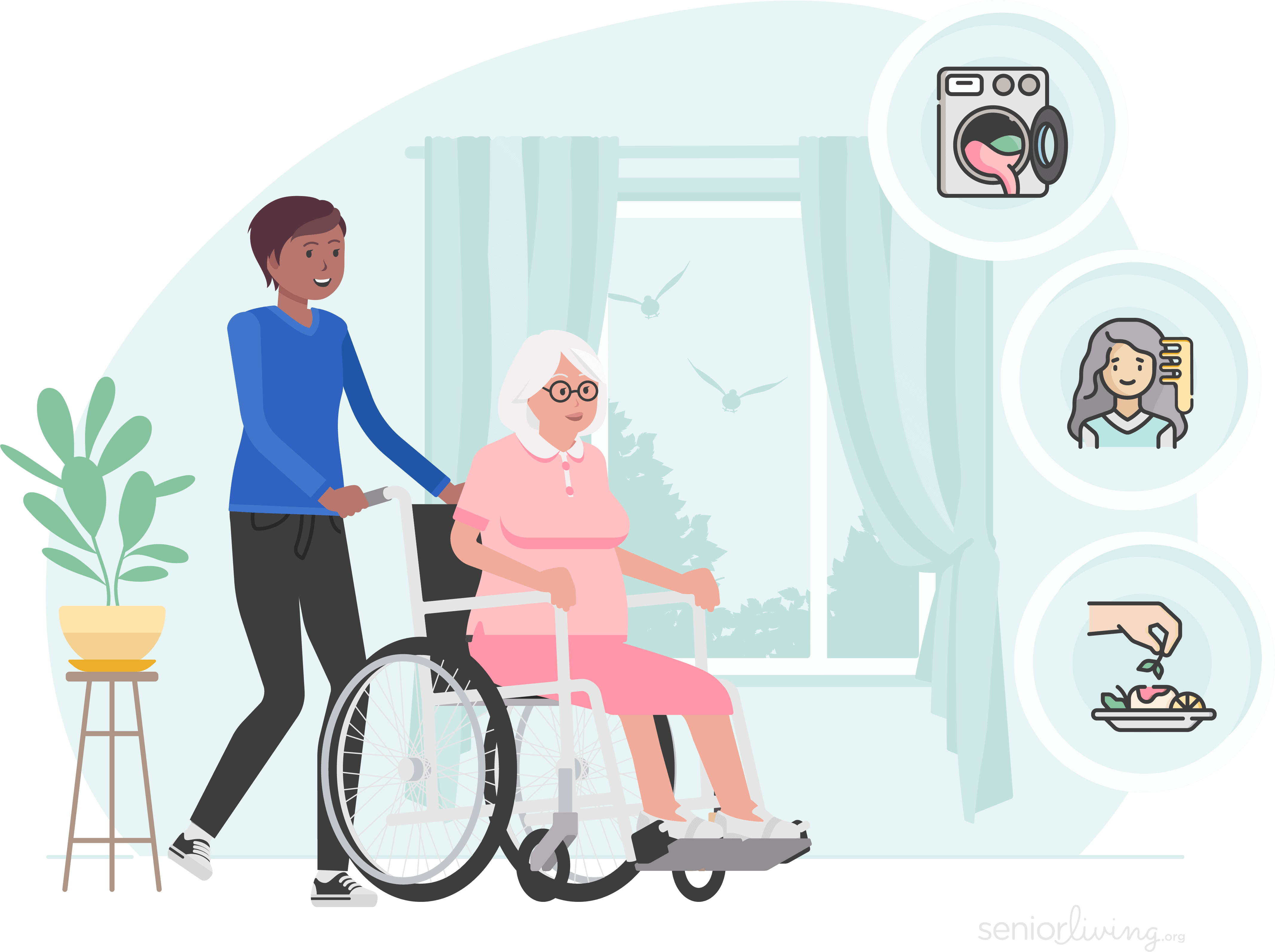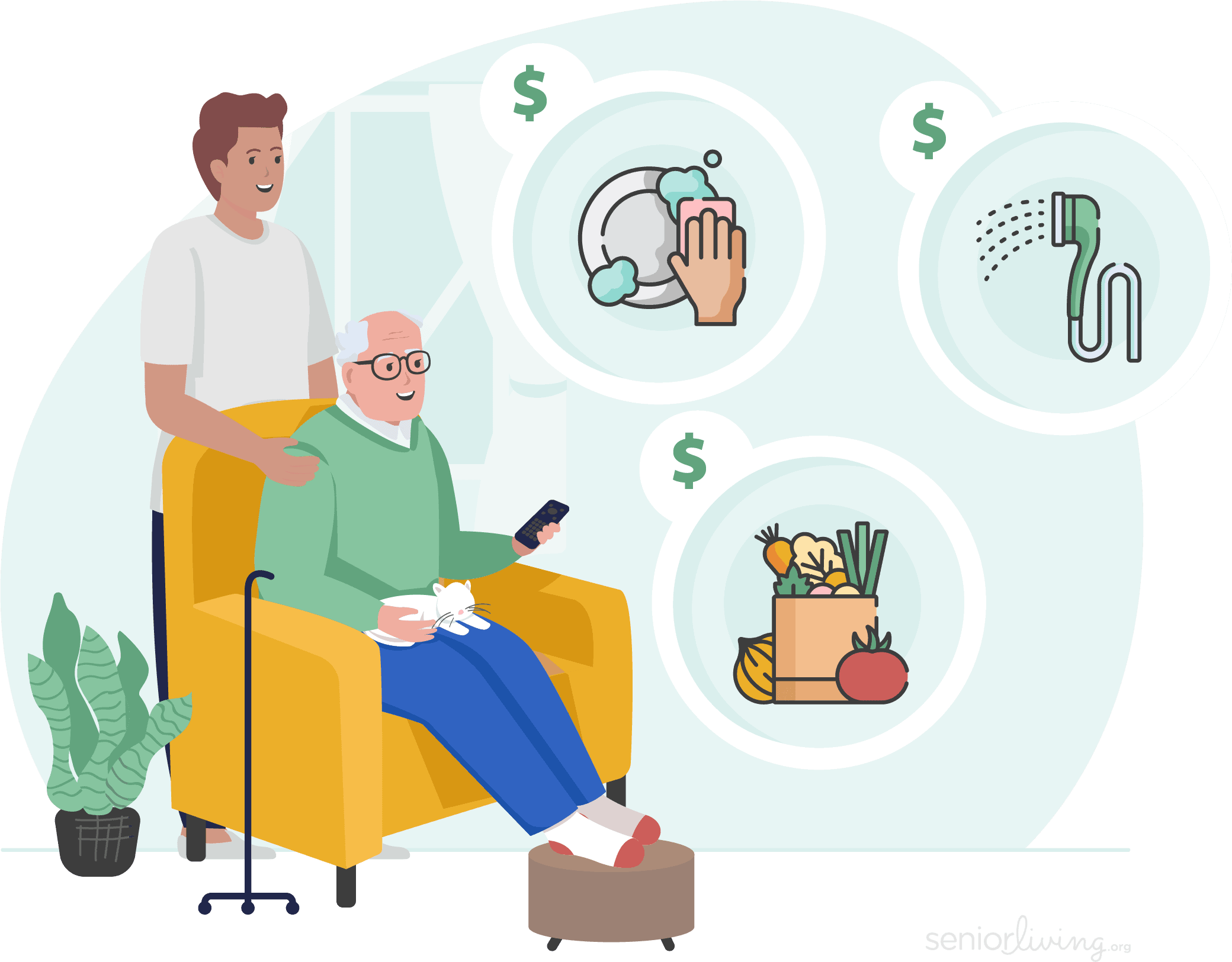Live-In Home Care for Seniors
SeniorLiving.org is supported by commissions from providers listed on our site. Read our Editorial Guidelines
Find Live-In Care Near You
Join 16,943 Families Who've Found Home Care Options on SeniorLiving.org.
Find Live-In Care Near You
Sometimes having help available only during the day isn’t enough, but moving into a senior group home, hospice center, or assisted living facility isn’t what you want. With live-in home care, you can stay in your own home while receiving around-the-clock help from a caregiver.
We’ll explore live-in home care in depth, including what it is, how it’s beneficial to older adults, and how to pay for it.
Table of Contents
- What Is Live-In Senior Care?
- How Does Live-In Senior Care Work?
- Live-In Care Services
- What Are the Different Types of Live-In Care?
- What Are the Benefits of Live-In Home Care?
- Who Requires Live-In Care?
- How to Evaluate Your Needs for Live-In Care
- How Much Does Live-In Senior Care Cost?
- Paying For Live-In Care
- How Do I Find a Live-In Caregiver for Seniors?
- Tips for Choosing a Live-In Care Agency
What Is Live-In Senior Care?

Live-in elder care is a 24-hour service that focuses on keeping you safe and happy in your own home. Caregivers help with personal care, such as bathing and shaving, as well as activities of daily living. This level of service is often provided by a nursing service or home health company, but you can also privately hire a live-in caregiver.
Did You Know? In 2019, 80 percent of adults who required long-term care lived at home, and unpaid family caregivers provided 90 percent of their care.1Read More about Family Caregiver Statistics.
A live-in caregiver’s shift can range from eight hours to several days. In most situations, live-in caregivers don’t actually move into your home, but they likely sleep in your home several nights per week during their shift. When their shift ends, they return to their primary residence.
Our free housing and care finder uses your unique needs to curate a list of the best options in your area.
How Does Live-In Senior Care Work?
Three types of home care arrangements fall into the category of live-in home care. One involves the caregiver moving into your home, while the other two do not.
Live-In Caregiver: Separate Residences
With this caregiver arrangement, a caregiver spends several nights per week in your home yet maintains their own separate residence. They typically work four or five days a week, staying in your home to provide 24-hour care during their workweek. You must provide them with a private room and bed, as well as access to a shower. Alternate caregivers provide care for the other two or three days per week.
Live-in caregivers don’t stay awake all night though. They sleep for eight hours each night, but it’s interrupted if you require any assistance, such as help getting to the bathroom.
In this arrangement, the caregiver also gets a break each day. The break may take place in your home, or they may be allowed to leave. An alternate professional caregiver or a family caregiver can fill in during the break depending on your care plan and needs.
Live-In Caregiver: Live Together
Some live-in caregivers move into the home full time. They have a private bedroom in your home and do not maintain a separate residence. In this caregiving situation, however, the caregiver doesn’t work nonstop. They sleep during the night — providing care as needed — and receive breaks during the day.
FYI: Are you a family caregiver? Your well-being matters! Hiring a live-in caregiver is one way to care for your loved one and yourself. Take some time to learn about other types of help available to family caregivers of seniors.
A secondary caregiver may fill in during nights off or breaks, but it depends on the needs and desires of you and your family. During the caregiver’s nights off, for example, a family member could come over to make dinner, get you ready for bed, and provide overnight care.
24-Hour Caregiving
Some seniors require 24 hours of awake caregiving. In these cases, a caregiver isn’t actually living in your home. Instead, you have an awake caregiver in your home at all times. It typically involves two or three caregivers who work eight- or 12-hour shifts.
Unless the family approves sleep time, these caregivers must remain awake for the duration of their shift. You aren’t required to provide caregivers with a private room to sleep in or space in the bathroom for hygiene items. This arrangement is best for seniors who require high levels of care.
Live-In Care Services
The kinds of services provided depend on the agency and the individual caregiver, as well as your individual care plan. In general, live-in home care providers offer services including:
- Supervision.
- Companionship, such as conversation, listening to music, watching movies, crafting, gardening, and playing games.
- Exercising, such as going on walks and to the gym.
- Assistance with bathing, grooming, toileting, and dressing.
- Mobility and transfer assistance.
- Medication management.
- Light housekeeping and laundry.
- Running errands and shopping.
- Meal planning, preparation, and clean-up.
- Transportation to doctor’s appointments, worship services, the senior center, fitness classes, volunteer meetings, and museums.
- Alzheimer’s and dementia care.
- Assistance with pets.
- Assistance with appointments.
- Writing letters.
- Paying bills.
Care can also include trained nursing services if that’s the level of care you require. The care is similar to what you might receive in a nursing home.
FYI: With waterproof help buttons and fall detection, Medical alert systems nicely complement in-home care. They can also provide peace of mind to family members, especially during a live-in caregiver’s break time.
Care.com connects families with qualified caregivers.
What Are the Different Types of Live-In Care?
There are some specialized types of live-in care designed to meet the unique health needs of seniors. Let’s take a look:
- Live-in memory care works well for people with various stages of dementia. Memory caregivers help keep you safe without isolating you. Care may involve day trips to the senior center, doctor’s appointments, and other outings that enrich your life. Generally, caregivers have more experience dealing with seniors who have dementia, including behavior modification. With the use of tools such as bed alarms, the caregiver is still able to sleep at night. This type of service can be a great respite care option for family caregivers.
- Live-in hospice care provides end-of-life care for people of any age who are terminally ill. Your hospice team will provide care that fulfills your hospice care plan, such as assisting with bathing, preparing meals, managing medications, and providing companionship. Hospice also provides services to the entire family, such as grief counseling.
What Are the Benefits of Live-In Home Care?
According to AARP, 77 percent of adults ages 50 and older want to remain in their own homes for the long term.2 Services such as live-in home care can make this goal a reality for seniors who live alone yet require extra assistance and supervision.
Along with allowing seniors to safely age in place, live-in care provides many other benefits.
- One-on-one care for improved patient safety.
- Building a trusting, personal relationship with a reliable caregiver.
- Less turnover than hourly aides and part-time nurses.
- Regular exercise, ambulation, and help with ongoing therapy, such as tasks that may be considered home instructions from physical therapy or occupational therapy.
- Improved nutrition through dietary management and meal preparation.
- Improved medication management and reminders to take medication as prescribed.
- Improved socialization, especially for older adults who are isolated.
- Improved family involvement.
- Decreases in stress and anxiety.

SeniorLiving.org is supported by commissions from providers listed on our site. Read our Editorial Guidelines
Who Requires Live-In Care?
Live-in senior care can be a great option for older adults who:
- Are recovering from a sickness or illness.
- Have limited mobility.
- Are isolated and withdrawn from others.
- Are feeling overwhelmed taking care of themselves.
- Live far away from family or friends who could lend a hand.
- Are suffering from Alzheimer’s or dementia.
- Are in hospice.
- Require care throughout the night.
How to Evaluate Your Needs for Live-In Care
Every older adult has unique needs that must be met so they can age safely and happily at home. Before hiring a live-in caregiver, carefully consider your needs throughout the day and night so you can better assess if an individual caregiver or agency is a good fit.
- Hours: How many hours a day do you need care? When is care needed most? Will you require help in the middle of the night with going to the bathroom?
- Dietary: Do you have allergies or special cooking requirements? How will groceries be purchased?
- Transportation: Do you need transportation to doctor’s appointments, social events, or other activities? Can the caregiver drive your car? Will they be insured for it? Can the caregiver escort you on public transportation, such as a bus or taxi?
- Medication management: How do you currently manage medication? Are medications being taken correctly? What side effects are there to your medications? How often are they being refilled?
- Memory loss: Do you have memory loss? Do you need to be tested? Knowing that will help the agency assign a properly trained caregiver.
- Other skills: Are there other requirements, such as blood-sugar testing and taking blood pressure readings?
How Much Does Live-In Senior Care Cost?
The cost of live-in care varies from state to state and from one agency to the next. It also depends on the level of care required. According to the Genworth Cost of Care Survey, in-home caretaker services have an estimated median cost of $30.90 per hour, and in-home home health aide services have a median cost of $33.99 per hour.3
Estimated Median Cost of Live-In Senior Care
| Care provided | Median daily cost in 2024 | Median monthly cost in 2024 |
|---|---|---|
| 24 hours of awake care, 7 days per week |
$744 to $814 | $22,495 to $24,745 |
| 16 hours of awake care, 7 days per week |
$495to $543 | $14,997 to $16,496 |
| 24 hours of awake care, 5 days per week |
$530 to $582 | $16,068 to $17,675 |
| 16 hours of awake care, 5 days per week |
$354 to $387 | $10,712 to $11,783 |
Helpful Hint: Learn more about the cost of live-in care in our guide to senior in-home care costs.
Paying For Live-In Care
Live-in care is expensive, but you may not need to pay the full cost out of pocket. There are several ways to pay for care, depending on your insurance, where you live, and your reason for needing care.
Using Medicare to Pay for Live-In Care
Medicare won’t pay for live-in caregivers or 24-hour-a-day care at your home.4
Medicare may cover the costs if you require only intermittent or part-time home health aide services, but coverage is available only to home-bound seniors who meet certain criteria. Learn more in our guide to paying for home care services.
Using Medicaid to Pay for Live-In Care
Medicaid is jointly funded by the federal government and each state, so coverage varies from one state to the next. Review your state’s Medicaid policy to see what coverage is available. The majority of states offer some sort of financial assistance for home care, typically called HCBS waivers. The waiver allows seniors who require nursing home–level care yet want to receive their care at home instead of in a nursing home. Money from this program may be able to cover a live-in caregiver.
Using Veterans Benefits to Pay for Live-In Care
Veterans who meet certain criteria have access to two programs that can fund live-in care costs.
- Homemaker and home health aide care: Under this program, VA-contracted homemaker and home health aide organizations provide veterans with personal-care services and help with activities of daily living.5 It’s part of the VA’s home- and community-based services.
- Veteran-directed care: Under this program, you can receive personal-care services and help with activities of daily living in your own home. The VA gives you a budget to hire your own workers. You could even use funds to hire a family member, friend, or neighbor as your caregiver.6
Using Long-Term Care Insurance to Pay for Live-In Care
Long-term care insurance policies cover a lot of services that Medicare, Medicaid, and private health insurance don’t cover. If you already have a long-term insurance plan, review the policy. It likely covers expenses related to a live-in caregiver.
Using Private Funds to Pay for Live-In Care
Many older adults pay out of pocket for live-in care. They use a combination of Social Security income, pensions, other retirement income, savings, and family contributions. Reverse mortgages are another option. They allow you to use your home’s equity as cash to cover the expense of your live-in caregiver.
If your private funds are limited, you may consider a live-in caregiver arrangement in which the caregiver moves into your home. You can offer room, board, and access to a car to offset their wages.
How Do I Find a Live-In Caregiver for Seniors?
We make it easy to find live-in home-care providers. Visit our tool to search by ZIP code. Type in your ZIP code, choose “home care,” and download a list of results.
You can also find live-in caregivers by:
- Researching home-care agencies. Do an internet search for “live-in caregivers near me” or “home-care agencies near me.” Review the services offered, online reviews of the agency, and whatever information you can find about cost. Set up phone calls or in-person meetings to discuss how each agency can meet your needs.
- Researching hospice. If you require a live-in caregiver as part of hospice care, search online for “hospice home care near me” or “hospice services in [city/state].” Many hospice providers expect family members to actively participate in their loved one’s care, but 24-hour care is available as needed.
- Using Eldercare Locator. This is a free service provided by the U.S. Administration on Aging that connects older adults with community resources. You can use the online Eldercare Locator search tool or call 1-800-677-1116 to find information on local senior organizations in your area, such as your state Department of Aging or your local Area Agency on Aging. Use those resources to help you find information on home-care services.
- Talking to friends and neighbors. Find out if anyone in your neighborhood, friend group, workplace, or worship community has had to organize live-in care. They may be able to refer you to an agency or individual live-in caregiver.
Tips for Choosing a Live-In Care Agency
Since most seniors prefer aging at home, it’s now easier than ever to find live-in caregivers. It might take a little effort to find a person whose personality and skill set meshes with your loved one. Think of the process like a job candidate search, and you are the employer. You want just the right fit for your team.
Here are some areas to consider in the hiring process:
- If working with an agency, find out exactly what is covered. Read the contract carefully. What fees are included and what services cost extra? How is a contract terminated by either party? How much notice is required?
- Is the agency Medicare-certified? That means it follows a set of stringent federal guidelines to be able to provide care, and it has also been inspected.
- Interview several candidates before hiring. Meet the caregiver in a public place first, before inviting them to your home. Ask them about their experience and qualifications. Give them worst-case scenarios about what they can expect. Don’t sugarcoat anything. It’s better to have all expectations and potential trouble areas out in the open. Ask if they’ve ever worked with someone with similar needs. Ask open-ended questions.
- Check references. Be careful and diligent when talking to references. Would the reference use the caregiver again?
- Do background checks on your top candidates. An agency usually will provide this service. Do they provide a criminal background check? Credit check? Driving record? Legal working status?
It’s important to keep in mind that there are both licensed and unlicensed home-care agencies. The hiring process with the two types of agencies likely isn’t the same. It’s a good idea to work with an agency that adheres to state and governmental rules and regulations for hiring caregivers, which means criminal background checks, health screenings, verified medical certifications, and reference checks. A quality agency also verifies the skill levels of the people they employ.
American Family Physician. (2019). Caregiver Care.
AARP. (2021, Nov 18). Despite Pandemic, Percentage of Older Adults Who Want to Age in Place Stays Steady.
Genworth. (2022, Jun 2). Cost of Care Survey.
Medicare.gov. (2023). Home health services.
U.S. Department of Veterans Affairs. (2023, Feb 15). Homemaker and Home Health Aide Care.
U.S. Department of Veterans Affairs. (2023, Feb 15). Veteran-Directed Care.




